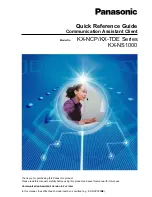
38
2.
Center the Moon in the field of your NexStar telescope.
3.
Focus the telescope by turning the focus knob until the image is sharp.
4.
Set the shutter speed to the appropriate setting (see table below).
5.
Trip the shutter using a cable release.
6.
Advance the film and repeat the process.
Lunar Phase
ISO 50
ISO 100
ISO 200
ISO 400
Crescent
1/2
1/4
1/8
1/15
Quarter
1/15
1/30
1/60
1/125
Full
1/30
1/60
1/125
1/250
The exposure times listed in table 8-1 should be used as a starting point. Always make exposures that are longer and
shorter than the recommended time. Also, take a few photos at each shutter speed. This will ensure that you will get a
good photo.
•
If using black and white film, try a yellow filter to reduce the light intensity and to increase contrast.
•
Keep accurate records of your exposures. This information is useful if you want to repeat your results or
if you want to submit some of your photos to various astronomy magazines for possible publication!
•
This technique is also used for photographing the Sun with the proper solar filter.
E
E
E
E
E
E
E
E
y
y
y
y
y
y
y
y
e
e
e
e
e
e
e
e
p
p
p
p
p
p
p
p
iiii
iiii
e
e
e
e
e
e
e
e
c
cc
c
c
cc
c
e
e
e
e
e
e
e
e
P
P
P
P
P
P
P
P
rrrr
rrrr
o
o
o
o
o
o
o
o
jjjj
jjjj
e
e
e
e
e
e
e
e
c
cc
c
c
cc
c
tttt
tttt
iiii
iiii
o
o
o
o
o
o
o
o
n
n
n
n
n
n
n
n
This form of celestial photography is designed for objects with small angular sizes, primarily the Moon and planets.
Planets, although physically quite large, appear small in angular size because of their great distances. Moderate to high
magnification is, therefore, required to make the image large enough to see any detail.
Unfortunately, the
camera/telescope combination alone does not provide enough magnification to produce a usable image size on film. In
order to get the image large enough, you must attach your camera to the telescope with the eyepiece in place. To do so,
you need two additional accessories; a deluxe tele-extender (#93643), which attaches to the visual back, and a T-ring
for your particular camera make (i.e., Minolta, Nikon, Pentax, etc.).
Because of the high magnifications during eyepiece projection, the field of view
is quite small which makes it difficult to find and center objects. To make the
job a little easier, align the finder as accurately as possible. This allows you to
get the object in the telescope's field based on the finder's view alone.
Another problem introduced by the high magnification is vibration.
Simply
tripping the shutter
even with a cable release
produces enough vibration to
smear the image. To get around this, use the camera's self-timer if the exposure
time is less than one second
a common occurrence when photographing the
Moon.
For exposures over one second, use the "hat trick."
This technique
incorporates a hand-held black card placed over the aperture of the telescope to
act as a shutter. The card prevents light from entering the telescope while the
shutter is released. Once the shutter has been released and the vibration has
diminished (a few seconds), move the black card out of the way to expose the film.
After the exposure is complete, place the card over the front of the telescope and
close the shutter. Advance the film and you're ready for your next shot. Keep in mind that the card should be held a
few inches in front of the telescope, and not touching it. It is easier if you use two people for this process; one to
release the camera shutter and one to hold the card. Here's the process for making the exposure.
1.
Find and center the desired target in the viewfinder of your camera.
Table 8-1
Above is a listing of recommended exposure times when photographing the Moon at the
prime focus of your NexStar telescope.
Figure 8-1 - Accessories for
Projection Photography
Summary of Contents for NexStar 11
Page 1: ...I IN NS ST TR RU UC CT TI IO ON N M MA AN NU UA AL L...
Page 61: ...61 APPENDIX E MAPS OF TIME ZONES...
Page 62: ...62...
Page 63: ...63...
Page 64: ...64...
Page 65: ...65...
Page 66: ...66...
Page 67: ...67...
Page 68: ...68...
















































